Southern California Contest Club
ARRL 10-Meter: December 13-14 Stew Perry Topband: December 27-28 ARRL RTTY Roundup: January 3-4
ARRL 10-Meter: December 13-14 Stew Perry Topband: December 27-28 ARRL RTTY Roundup: January 3-4
Past Feature Stories (Newest to Oldest)
Jumanji Contest Station HK1NA - Jorge Prieto HK1R
August 2014
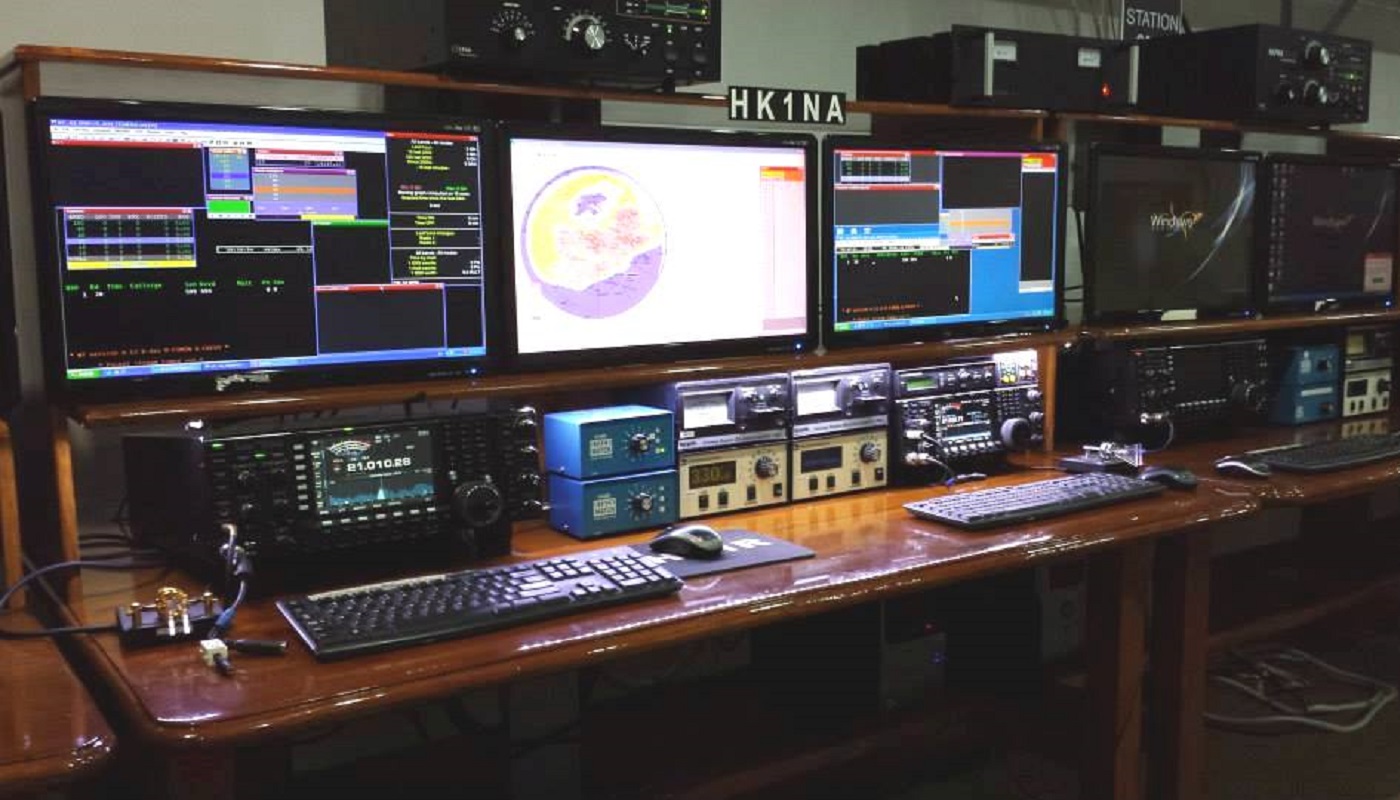 Since I started in HAM radio in the early 80´s the activity that interested me the most were the contests. Ham radio contesting in Colombia has taken a huge step
forward in the last 4 years.
Since I started in HAM radio in the early 80´s the activity that interested me the most were the contests. Ham radio contesting in Colombia has taken a huge step
forward in the last 4 years.Many Colombian amateur radio enthusiasts, sometimes encouraged by some foreign ham operators, made timid appearances in various competitions and categories with the only intention to participate and not winning.
Some ham operators made individual efforts in stations that had many limitations because they were located in a big town with thousands of electric cables and noise and interference from all sorts of electric devices, which made them less competitive. more
In 1987 with my original call HK1KYR I decided to actually compete in a big contest and win it. I had my eye on the ARRL DX CW, I operated in the SOSB 15 meter category, my goal was to be the best world wide, I installed a 5 element antenna for that band and achieved my goal, 1st place worldwide. For the first time a HK station won first place in a big contest.
After 1988, my job, new responsibilities and other hobbies reduced my activity in Ham Radio.
Colombia is a country that has been the victim of violent situations; this made it difficult to install a station out in the rural areas around the end of the 80´s and 90´s because we felt safer in the big cities. In 2004 things started to change and year after year safety increased and Colombians started to enjoy several things that had been impossible in the past.
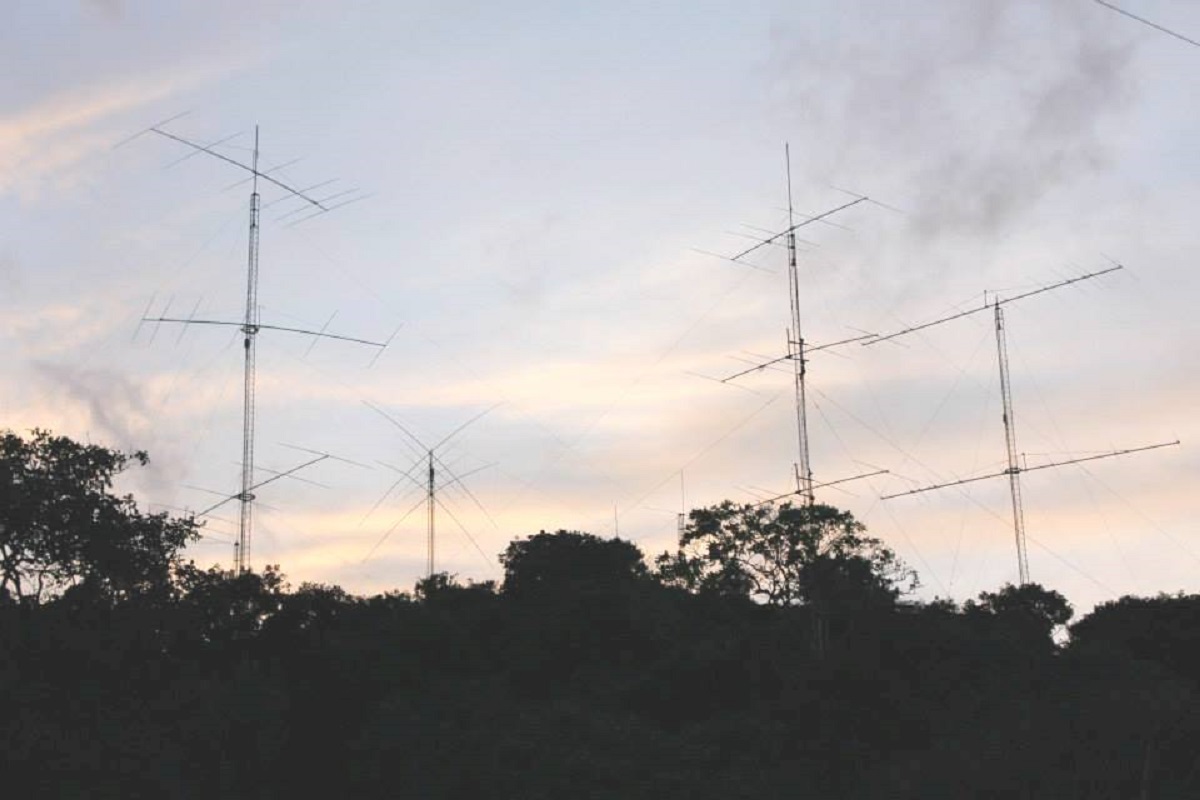 Finally in 2010 with the security issues behind us, a group of old ham friends decided to build a world class contest station on a 400 acre property located between
Cartagena and Barranquilla, just 2 kilometers from the Caribbean sea. None of us had previous experience to design and build a project of this magnitude.
Finally in 2010 with the security issues behind us, a group of old ham friends decided to build a world class contest station on a 400 acre property located between
Cartagena and Barranquilla, just 2 kilometers from the Caribbean sea. None of us had previous experience to design and build a project of this magnitude.When we started this adventure, it wasn´t only to build towers and antennas, it also included preparing and training to operate this type of station with efficiency and professionalism.
This project started with, HK1NK Sal (now HK1T), HK1XX Pedro (now HK1X), HK1KXA David (now HK1A), HK3AHM Jim (now HK1N), HK1AMW Bolmar (today HK1MW) and HK1KYR Jorge (now HK1R)
This is how we started to build HK1NA.
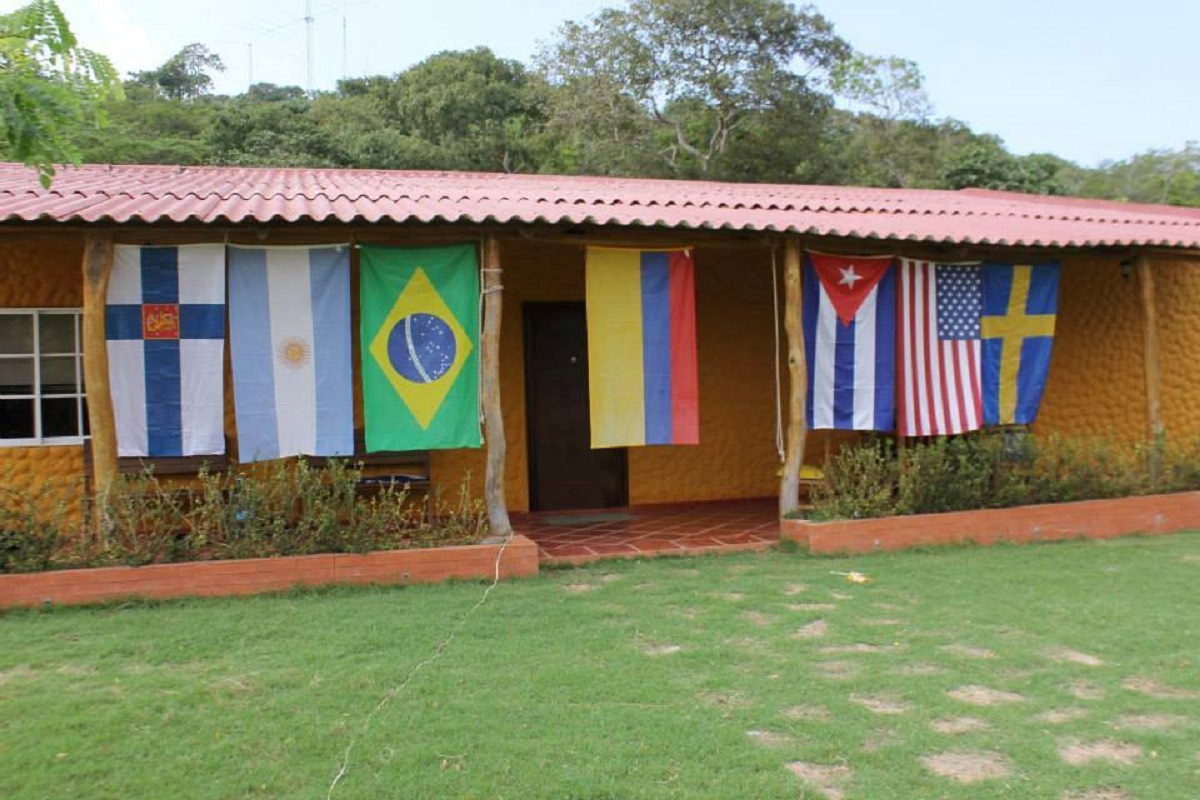 Today, after 4 years of continuous improving, the station has six operating positions, one per band. Each position is equipped for 2O2R (Two operators Two radios).
Usually per band we have an ICOM7700 Radio and, as a second radio, an ICOM 7600. The amplifiers that we use are the Alpha 8410.
Today, after 4 years of continuous improving, the station has six operating positions, one per band. Each position is equipped for 2O2R (Two operators Two radios).
Usually per band we have an ICOM7700 Radio and, as a second radio, an ICOM 7600. The amplifiers that we use are the Alpha 8410.Since the beginning of the HK1NA station we have received the visit of many radio amateurs from around the world (contesters and DXers), we have learned so much from each visit and enjoyed every single one of them.
HK1NA has been a big challenge for us and has filled us with satisfaction, our achievements have exceeded our initial expectations but we continue growing. We have new projects and many aspects to improve on. All the above keeps us enthusiastic, with the drive to compete and the hopes to make new friendships in the ham radio world. More pictures: 1 2 3 4 5 close
The G5W Contest Station - Don Beattie G3BJ
August 2014
 My interest in contests goes back some forty years. With a modest station in a suburban location, I was able to win, or almost win, some of the RSGB contests of
those days. But of course, things have changed. Over those forty years, beam antennas have become the “norm”, towers are much more easily obtained and big linears
are commonplace. And so my contesting aspirations changed as well.
My interest in contests goes back some forty years. With a modest station in a suburban location, I was able to win, or almost win, some of the RSGB contests of
those days. But of course, things have changed. Over those forty years, beam antennas have become the “norm”, towers are much more easily obtained and big linears
are commonplace. And so my contesting aspirations changed as well.In the 1990’s, with a slightly less modest station in a semi-rural village location, I began to build a multi-single capability. We formed a contest club (at a time when only clubs could be allocated short contest calls) and acquired the rights to what would eventually settle down as G5W. In the 90’s, however, the year influenced the call – so I have operated as G6W, G7W etc etc. Eventually, our regulator took a progressive attitude towards contest calls, “froze” the number (we could choose which) and opened the short contest calls to everyone who had a genuine interest in serious contesting. more
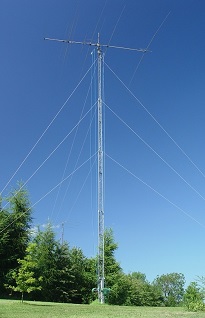 Initially there was only one tower and beam, backed up with dipoles and verticals. Even then, we began to feature in leading positions in the UK in multi-operator
categories. But work at the salt mine prevented any serious optimisation of the station and it all took a back seat until I was able to retire some fourteen
years ago.
Initially there was only one tower and beam, backed up with dipoles and verticals. Even then, we began to feature in leading positions in the UK in multi-operator
categories. But work at the salt mine prevented any serious optimisation of the station and it all took a back seat until I was able to retire some fourteen
years ago.We then took a decision to have a lifestyle change, and move to the country. We moved out of the South-East of England, and bought a house on the border of England and Wales, on a windy hilltop near a small hamlet called Woolston, in the county of Shropshire.
Shropshire is one of the less developed areas of England and the Southern part, where we now live, is mainly hilly and given over to sheep farming. It is a particularly pretty part of England, and the house we bought is in an “Area of Outstanding Natural Beauty” – a landscape categorisation which means that planning (zoning) laws are more stringent than elsewhere.
Given that one of the reasons for moving to the country was to develop the radio station an antenna farm, I took care to discuss my intentions with the local planners. After a short while in the discussion, the officer I met said “Ah yes…..amateur radio – we’ve had one or two of those before. But you take the towers with you when you move, don’t you?” I confirmed that I would not leave them after we moved on. “Oh well, I don’t see a problem” was the response. Good news indeed, for in parts of the UK, other amateurs have great problems gaining approval for even modest antennas.
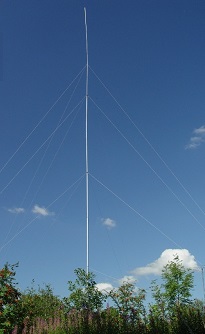 And so the slow process started of rebuilding the station at the new location. By US and other standards, it remains modest. The main tower is 80ft, with a ten
element Force 12 yagi for 40-10. That tower also supports the centre of 80 and 160m dipoles. A Titanex 90ft vertical provides some capability on 160, 80 and 40.
And a second tower with a SteppIR at 60ft gives a second HF capability. Both towers are on the top edge of a downward slope, in the direction of the US. This
appears to give a pleasingly low angle in that direction. All antennas have to have high wind tolerance – 90 mph (145 kph) is not an unknown wind strength here.
And so the slow process started of rebuilding the station at the new location. By US and other standards, it remains modest. The main tower is 80ft, with a ten
element Force 12 yagi for 40-10. That tower also supports the centre of 80 and 160m dipoles. A Titanex 90ft vertical provides some capability on 160, 80 and 40.
And a second tower with a SteppIR at 60ft gives a second HF capability. Both towers are on the top edge of a downward slope, in the direction of the US. This
appears to give a pleasingly low angle in that direction. All antennas have to have high wind tolerance – 90 mph (145 kph) is not an unknown wind strength here.For LF receive, I started with a K9AY steerable loop, but have since added two beverages, the whole receive antenna system being fitted with 80 and 160m bandpass filters and preamplifiers, so that when operating multi single, the receive antennas can be shared with no interaction problems from the other transmitter.
I should say at this stage that we live in a very low noise environment. Because of the AONB categorisation, there are no overhead high voltage lines, and electrical noise is (almost) unheard of. A couple of instances when the local low voltage power line developed a fault were quickly cleared by the power company, who seem very keen to help.
Of course it would be nice to have a really big tower – say 150ft. But the AONB restrictions would then kick in, I feel, and also there are access issues for a big crane. So I am happy with the current installation, although I do have a 100ft tower lying in sections in the long grass…..I wonder?
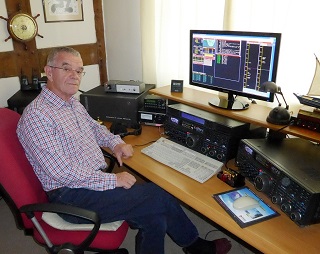 For RF equipment, I use two FTdx5000 transceivers, normally configured for SO2R, but easily re-set for multi-single or M2.The transceivers drive two linears – both
auto-tuned. There is a Microham SO2R controller and of course auto-switched bandpass filters on each transceiver. All antenna selection is automatic, although I
have an unusual arrangement with the two feed lines to the antenna field. I have two LDF feeds to remote switches. Let’s call them line A and line B.
For RF equipment, I use two FTdx5000 transceivers, normally configured for SO2R, but easily re-set for multi-single or M2.The transceivers drive two linears – both
auto-tuned. There is a Microham SO2R controller and of course auto-switched bandpass filters on each transceiver. All antenna selection is automatic, although I
have an unusual arrangement with the two feed lines to the antenna field. I have two LDF feeds to remote switches. Let’s call them line A and line B.Line A: 10-40m yagi (Force 12) alternatively switchable to three element tri band yagi fixed to Europe, 80m dipole, 160m dipole
Line B: 10-20m SteppIR yagi, 90ft Titanex for 40-80-160 with a big earth mat.
The unusual aspect is that I can switch lines A and B between transceiver/linear 1 or 2. Whilst this may sound strange, in fact it offers great flexibility. All band data and filters/antennas change in accordance with the band in use, so the A-B changeover is seamless.
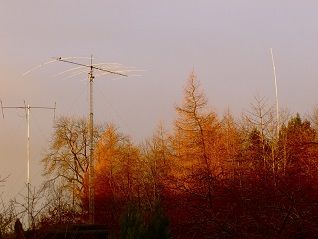 For MS or M2 contests, I can add a third work station using an Elecraft K3 (which I normally use for globe-trotting) and KPA500 linear, into whatever antenna seems
sensible for what will be a multiplier spotting station. Normally I erect a simple vertical for one or more bands.
For MS or M2 contests, I can add a third work station using an Elecraft K3 (which I normally use for globe-trotting) and KPA500 linear, into whatever antenna seems
sensible for what will be a multiplier spotting station. Normally I erect a simple vertical for one or more bands.I have several networked computers running Win-Test, a program that has never let me down. I evaluated a number of contest logging programmes some years ago, and decided that Win-Test with its bomb-proof networking, was the one for me. I’ve not regretted that decision. In multi-op contests, we’re connected to RBN and cluster, of course, and I also run a local skimmer here. Hilary, who shares my life with me, is also licensed (G4JKS) and so I am fortunate in getting great support from her when the house gets filled with contesters for one of the “big ones”. I still get a real kick out of operating in contests. Whilst this far north in Europe will never get a top place in the big contests, I do like to try to perform well against others at these latitudes.
At the time of writing we hold several UK records for the CQ contests, a first place (Europe) in the Stew Perry and numerous wins in domestic RSGB contests. But I’m never satisfied, and I’m sure tomorrow I’ll have another idea for that extra 0.25 dB. close
The YE2R Contest Team - Martinus Jap YB2LSR
August 2014
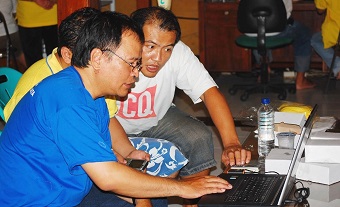 In the beginning in Indonesia (YB-land) there were not so many contesters who took part in International contests.
In the beginning in Indonesia (YB-land) there were not so many contesters who took part in International contests.Hans, YB2DX and I had an idea to create a contest team. We went to see our former ORARI Central Jawa (call area 2) Chairman Tim Hadi Dhanuwidjaja YB2AA (now SK).
We told him about our plan and asked for his advice, he was very helpful and supportive of our plan and after we got his permission we gave our contest team the call YE2R.
Just a note, previously the call sign YE2R had been used by Rivai YE3AA (ex YB2MTA) for an expedition in 2002. more
For our first time as the YE2R contest team we were QRV for CQWW-SSB 2009. The QTH was Grobogan – Purwodadi in Central Jawa. Our team had 17 members mostly inexperienced in contesting but with motivation and a good spirit we got a good result.
Our team members were not all from call area 2, we had support also from good operators in other call areas. They gave full support of our activity and a surprise in 2012 we were supported by Robert, KR7O. He is one of the best operators we have had from outside of Indonesia.
Year by year YE2R made good progress in the contest results. Every year we took part in the CQWW-SSB at the same QTH in Grobogan. Additionally, in 2012 we entered CQWW-160 SSB from Klirong – Kebumen in Southtern Central Jawa.
YB-Land is in a difficult location for contesting with much lower participation than EU or NA but we never give up and we are still striving to be the best.
On the subject of finances, the radios and antenna are mostly provided by Hans, YB2DX, and we share the accommodation. There has been some support by other local hams buying our T-Shirt with the YE2R logo.
More pictures: 1 2 3 4 5 6
de Martinus Jap, YB2LSR.
close
The 9K2HN Contest History - Hamad Alnusif 9K2HN
July 2014
 My name is Hamad Alnusif, I am Chairman of the Kuwait Amateur Radio Society (KARS) and my ham radio callsign is 9K2HN. I got started with ham radio in 1992 when I had
a very small station located in Kuwait City at the age of 16 years.
My name is Hamad Alnusif, I am Chairman of the Kuwait Amateur Radio Society (KARS) and my ham radio callsign is 9K2HN. I got started with ham radio in 1992 when I had
a very small station located in Kuwait City at the age of 16 years.After a few years I became interested in contesting and I started the journey to build up my station year after year.
In 2010 I realized that I would not be able to have the station of my dreams in the city, so I started building a new contest station from scratch in the northern part of Kuwait.
At the moment our station can run as Multi/Multi with 6 stations running at the same time and there is a future plan to expand it further to have a Multiplier station added. more
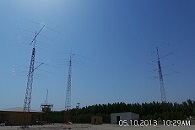

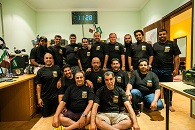
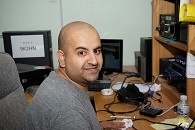
In the summer of 2013, after lot of thinking we have replaced all of our old antenna’s with new ones, with these changes our station has become one of the biggest contest stations in the area.
We are participating in all major contests, mainly Phone. Also in CW as a single operator. close
The SJ2W Contest Station - Mikael Larsmark SM2WMV
July 2014
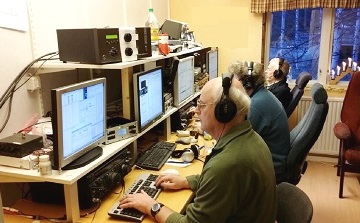 My name is Mikael Larsmark, SM2WMV and I'm 31 years old. I got my ham radio license when I was 15 and have always been having a big interest in building things.
My name is Mikael Larsmark, SM2WMV and I'm 31 years old. I got my ham radio license when I was 15 and have always been having a big interest in building things.Many of you active contesters on the west coast has probably heard SJ2W on 20m time and time again while the band has been rather dead towards Europe. With a station located up in the north part of Europe we have the advantage of having west coast openings very late and at times during full nights on 20m, sometimes even 15 but rarely on 10m.
This is our chance of being competitive and with absence of aurora we can even sometimes be rather competitive in Europe. However, when that layer of auroral absorption is there, we have no chance at all regardless of how big stations we build. more
The SJ2W station was started to be built in the autumn of 2008 when I bought a QTH located 64.5 degrees north about 180km from where I work.
The location was selected such that ham radio friends that I wanted involved in the project would not have such a long distance to travel, actually I am the one having the second furthest travel distance to the station.
It is not a station being built with a big budget but mostly paid with a normal workers salary, so a lot of the equipment we need to build ourselves, such as antennas, antenna switching, control systems etc.
At the beginning I made plans of what I wanted the station to look like within a few years. Things have taken a bit longer than anticipated but at the same time the plans have also grown.
The idea has always been to make a competitive M/S with four operating positions or SO2R type of station with high flexibility.
Each band is supposed to have two or three antenna systems with one of the antenna systems totally independent of the other bands.
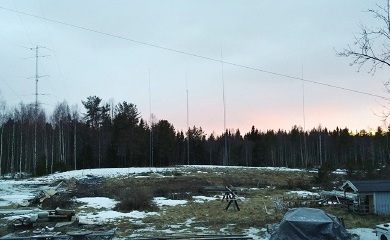 Lately we have also started to do what I call inband QSOs, where we do S&P on the RUN-band while the RUN-operator continues to work QSOs like normal. That way we
are able to work mults on the running band a lot faster and we can increase the number of QSOs as well. In the Russian DX for example we worked 2232 RUN QSOs,
657 S&P on the run band (inband) and 370 QSOs on the mult radio.
Lately we have also started to do what I call inband QSOs, where we do S&P on the RUN-band while the RUN-operator continues to work QSOs like normal. That way we
are able to work mults on the running band a lot faster and we can increase the number of QSOs as well. In the Russian DX for example we worked 2232 RUN QSOs,
657 S&P on the run band (inband) and 370 QSOs on the mult radio.The way we currently do this is that we have a vertical that is located about 450m away from the main antennas which the inband station use to listen, but whenever he decide to transmit the main antennas and amplifier are shifted from the RUN-station while the RUN-station gets to listen to the vertical. This is however not optimal and plans are to improve this system this summer by putting up a 30m high tower where the vertical is today, and put up a tribander + 2el for 40m which the inband station will use to both transmit and receive.
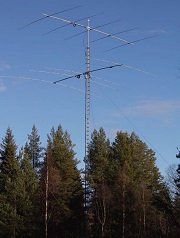 The whole station is controlled with a control system which I have designed and built myself that I call openASC. With this system we can control the whole station
with a single little box and in this way all operators can access all functions at the station without needing to yell to another operator to turn some antenna.
It makes operating the station very easy and safe.
The whole station is controlled with a control system which I have designed and built myself that I call openASC. With this system we can control the whole station
with a single little box and in this way all operators can access all functions at the station without needing to yell to another operator to turn some antenna.
It makes operating the station very easy and safe.During this 5 year period we have broken a total of 1 relay in the switch system but this was because of a software bug. By using this system we are also able to remote control everything at the station and with two remotes currently setup using remoterig with a TS-480 and an Elecraft K3, the guys involved in the station can have fun from home as well.
The plan for this summer is to try get the already mentioned inband tower up and running but also to put up another OH8QD 60m high rotatable tower. This tower was built by OH8QD in 1983 and put up in Moskojärvi which is far up north in Sweden. We were given the tower for free as long as we took it down so the cost for this was the expense of the crane for a few hours. The tower was in excellent condition since it was galvanized and the intention is to have a 5x6 el stack for 15m in it and also a 3el for 80m.
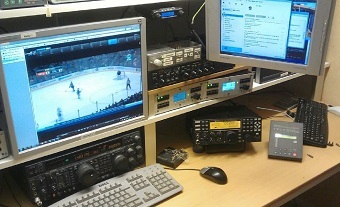 It still surprises me today the scores we have been able to produce at SJ2W. The number of QSOs we have been producing in the M/S category is far over what I ever
thought was possible from up north and what had been done before. Our highs have been close to 7800 QSOs in CQWW SSB and 6000 QSOs in CQWW CW and we've been setting
a lot of national and Scandinavian records that we are very proud of.
It still surprises me today the scores we have been able to produce at SJ2W. The number of QSOs we have been producing in the M/S category is far over what I ever
thought was possible from up north and what had been done before. Our highs have been close to 7800 QSOs in CQWW SSB and 6000 QSOs in CQWW CW and we've been setting
a lot of national and Scandinavian records that we are very proud of.The whole station project is very well documented on our website www.sj2w.se. I update the website several times a week during the more busy periods so that people are able to follow what happens and hopefully get inspired to do projects themselves, so be sure to check the website out! I would like to encourage more station builders to try sharing their work for others to get inspired. It just takes me a few minutes to update the website.
More pictures: 1 2 3 4 5 6 73 de Mike, SM2WMV (SJ2W) close






